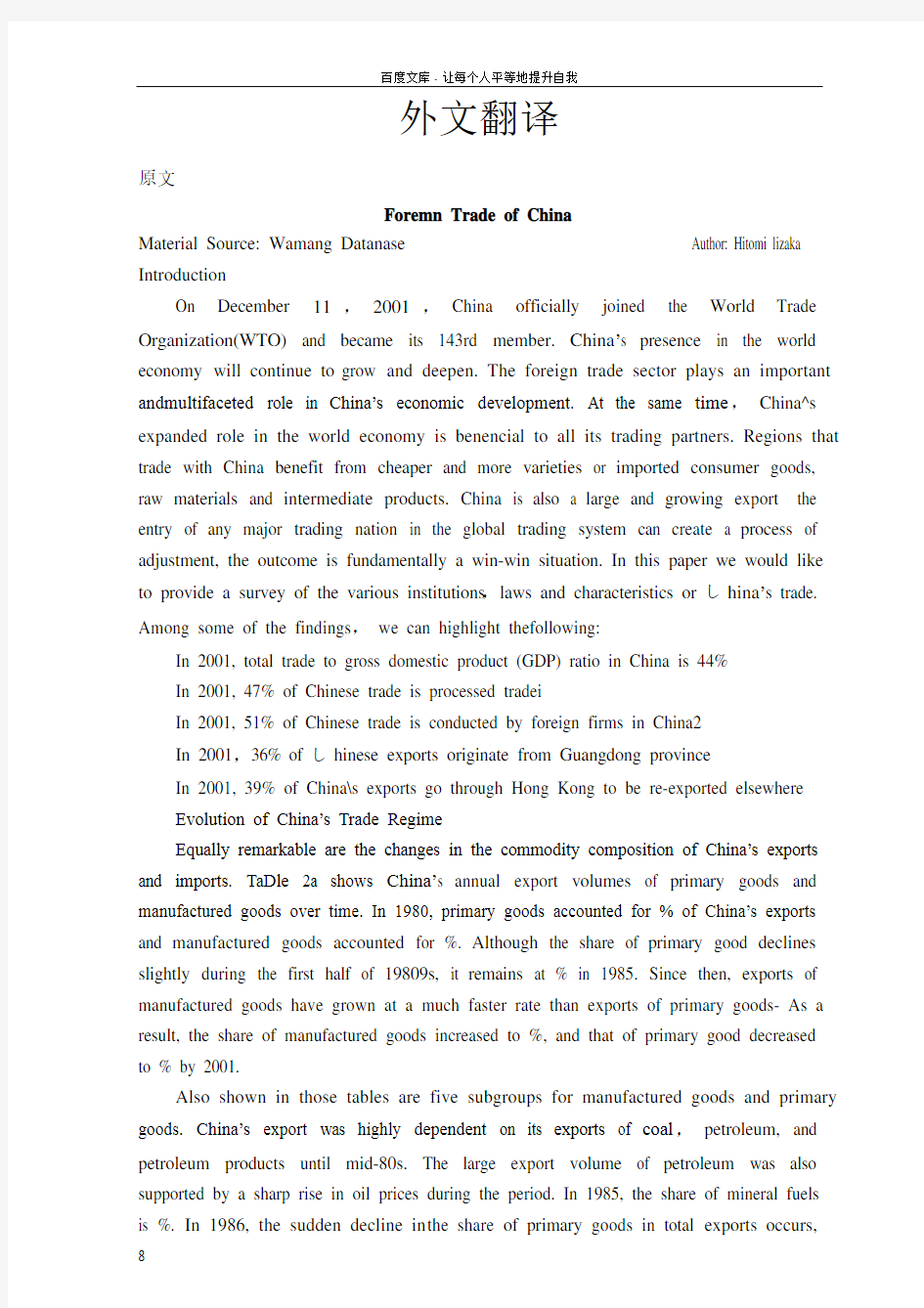
中国的对外贸易外文翻译
- 格式:docx
- 大小:42.46 KB
- 文档页数:8


外文翻译
原文
Foremn Trade of China
Material Source: Wamang Datanase Author: Hitomi lizaka Introduction
On December 11,2001,China officially joined the World Trade Organization(WTO) and became its 143rd member. China’s presence in the world economy will continue to grow and deepen. The foreign trade sector plays an important andmultifaceted role in China’s economic development. At the same time,China^s expanded role in the world economy is benencial to all its trading partners. Regions that trade with China benefit from cheaper and more varieties or imported consumer goods, raw materials and intermediate products. China is also a large and growing export the entry of any major trading nation in the global trading system can create a process of adjustment, the outcome is fundamentally a win-win situation. In this paper we would like to provide a survey of the various institutions,laws and characteristics or しhina’s trade. Among some of the findings, we can highlight thefollowing:
In 2001, total trade to gross domestic product (GDP) ratio in China is 44%
In 2001, 47% of Chinese trade is processed tradei
In 2001, 51% of Chinese trade is conducted by foreign firms in China2
In 2001,36% of しhinese exports originate from Guangdong province
In 2001, 39% of China\s exports go through Hong Kong to be re-exported elsewhere Evolution of China’s Trade Regime
Equally remarkable are the changes in the commodity composition of China’s exports and imports. TaDle 2a shows China’s annual export volumes of primary goods and manufactured goods over time. In 1980, primary goods accounted for % of China’s exports and manufactured goods accounted for %. Although the share of primary good declines slightly during the first half of 19809s, it remains at % in 1985. Since then, exports of manufactured goods have grown at a much faster rate than exports of primary goods- As a result, the share of manufactured goods increased to %, and that of primary good decreased to % by 2001.
Also shown in those tables are five subgroups for manufactured goods and primary goods. China’s export was highly dependent on its exports of coal,petroleum, and petroleum products until mid-80s. The large export volume of petroleum was also supported by a sharp rise in oil prices during the period. In 1985, the share of mineral fuels is %. In 1986, the sudden decline in the share of primary goods in total exports occurs,
which is largely associated with the decline in the export volume of mineral fuels. The price reforms coupled with the declined world petroleum price areattributable to the decline.
Domestic agriculture production expanded during the 1980\s in response to the higher prices through the price reforms and more opportunities given to the producers to market their products. Although the share of food and live animals in total exports has declined over time, China has become a net exporter of such products since 1984.
Turning to the manufactured goods, the large increase in the share of the manufactured goods in the total exports since mid-80s is largely accounted for by the increase in the export in the textile category and the miscellaneous products category. These two groups include labor-intensive products such as textiles, apparel, footwear,and toys and sporting goods. During the 1990s,the category that exhibited the most significant surge in exports is machinery and transport equipment. Its share expanded from % in 1990 to % in 2001 •
China’s Processing Trade and Trade by Foreign Invested Firms
China established the legal framework for processing and assembly arrangements in 1979. Since then, China has built up considerable strengths in assembling and processing of industrial parts and components. It covers a wide range of industries such as electric machinery,automobile, aerospace,and shipbuilding. Table 3a and Table 3b demonstrate the amount of processing exports and imports and the importance of stateowned enterprises (SOEs) and foreign-invested enterprises (FIEs) in such forms of trade for 1995-200L Throughout the period from 1995 to 2001,the shares of these two types of processing exports exceed more than half of China’s total exports. In 2001, processing exports account for % of the total exports. As is seen in Table 3a, process & assembling was dominated by SOEs in 1995. However, the trend has been changing. The share of SOEs in process & assembling has been steadily declining over the years from 84% in 1995 to 62% in 2001 • The other type of trade,process with imported materials was largely conducted by FIEs and their shares have been gradually increasing from 81% in 1995 to 88% in 2001 • In China’s imports (see Table 3b), processing trade is relatively small compared to exports. After it peaked at 49% in 1997,processed imports decline to 39% in 2001 • The decreasing importance of SOEs can be seen in China^ imports as well. Shares by SOEs decreased from 81% in 1995 to 58% in 2001 for process & assembling, and from 18% to 7% for process with imported materials. The decreased role for SOEs in processing trade may reflect the inefficiency in conducting their business. Since 1997, the Chinese government decided to implement the shareholding system and to sell a large number of medium- and small-sized SOEs to the private sector. A number of larger